Woodie (car body style)

A woodie (or a woodie wagon) is a wood-bodied automobile, that became a popular type of
Originally, wood framework augmented the car's structure. Over time manufacturers supplanted wood construction with a variety of materials and methods evoking wood construction — including infill metal panels, metal framework, or simulated wood-grain sheet vinyl bordered with three-dimensional, simulated framework. Wood construction was evoked abstractly on the Nissan Pao (1989–1991) and Ford Flex (2009–2019) with a series of horizontal grooves and strakes.[1]
History
1930s and 1940s
As a variant of body-on-frame construction, the woodie as a utility vehicle or station wagon originated from the early practice of manufacturing the passenger compartment portion of a vehicle in hardwood. It was a modern interpretation of an earlier horse-drawn wagon called a shooting brake which was made entirely of wood used to transport hunting spoils, gun racks, and ammunition on shooting trips.[2][3]
Woodies were popular in the
-
1938 Ford Prefect woodie
-
1935 Jensen-Ford woodie
-
1946–1948 Nash Ambassador Suburban
-
The Biscúter Comercial 200C (Spanish)
-
Construction of wooden-framed station wagon body, 1947, Australia
-
1948 Chrysler Town and Country, a convertible woodie
1950s and 1960s
In 1950,
The British Motor Corporation (BMC) offered the Morris Minor Traveller (1953–1971) with wood structural components and painted aluminum infill panels — the last true mass-produced woodie. Morris' subsequent Mini Traveller (1961–1969) employed steel infill panels and faux wood structural members.
-
1950 Buick Roadmaster
-
1950 Chrysler Newport Town & Country convertible
-
1951 Ford Custom 79 Country Squire
-
1960s Morris Minor 1000
Simulated woodgrain
After the demise of models using actual wood construction, manufacturers continued to evoke wood construction with sheet-vinyl appliques of simulated wood grain, sometimes augmented with three-dimensional, simulated framework, and later by a simple series of indented grooves in the bodywork.
The 1966
Ford also marketed version of their
Introduced in 1981, the
Japanese carmakers shied away from the appearance apart from port-of-entry or dealer-installed trim offered to North American consumers, although Mazda equipped the 1972-1977 Mazda Luce/RX-4 optionally, Honda briefly offered the 1980 Honda Civic station wagon, and Nissan offered the appearance on the 1983-1987 Nissan Cedric V20E SGL and Nissan Gloria V20E SGL top trim package station wagons to Japanese customers only.
In 2010,
Introduced in 2008, the Ford Flex featured a series of side and rear horizontal grooves intended to evoke a woodie look—without either wood or simulated wood. Car Design News said the styling references "a previous era without resorting to obvious retro styling cues."[1]
-
1966 Chevrolet Caprice Estate
-
1968Ford LTDCountry Squire
-
1974 Chevrolet Vega Estate
-
1973Chevrolet El Camino Estate
-
1974 Pontiac Grand Safari
-
1977 American Motors Pacer
-
1980 Honda Civic Country
-
1984 Mercury Colony Park
-
1988 Chevrolet Caprice Classic
-
1985 Plymouth Voyager
-
1986 Ford LTD
-
1986 Jeep Grand Wagoneer
-
1993 Jeep Grand Wagoneer
-
Buick Roadmaster Estate (1991-1996), the US' last full-sized station wagon
-
2009 Ford Flex with horizontal grooves to evoke wood[1]
Legacy
Columbia Pictures' top-grossing film for the 1940s, director John Stahl's 1945 Leave Her to Heaven starring Gene Tierney and Cornel Wilde, features a "woodie" station wagon early in the film. Many other American movies from the 1940s also feature woodies.
The woodie was also closely associated with surfers and
In 1995, the U.S. Postal Service issued a 15 cent stamp commemorating the woodie wagon.[12]
See also
- Station wagon
- Shooting-brake
- Surf culture
- Wood trim
References
- ^ a b c "Driven: Ford Flex". Car Design News Joe Simpson, Dec 26 2008. Archived from the original on 2010-06-28.
Reminiscent of the infamous "woodie wagons" of the '50s, the Flex's aesthetic is notable for referencing a previous era without resorting to obvious retro styling cues. Woodie wagons, such as the type-defining 1953 Buick Roadmaster estate, featured wooden exterior panels towards the rear of the car. The Flex reinterprets this through four distinctive horizontal grooves set into the lower half of both front and rear door panels, and a brushed-aluminum tailgate finish.
- ISBN 978-0-7478-0666-0.
- ^ Terry, Christopher William (1914). Motor Body-building in all its Branches. London: E. & F.N. Spon. p. 6.
shooting-brake.
- ^ Street Rodder, 7/94, p.90 caption.
- ^ Hot Rod Magazine, 7/90, p.50.
- Georgano, G. N.Cars: Early and Vintage, 1886–1930. (London: Grange-Universal, 1985)
- ^ Little-known Vega Development stories by John Hinckley, GMAD-Lordstown Vega Launch Coordinator
- ^ 1973 Chevrolet Vega brochure Jan. 1973
- ^ "Against the Grain: 21 Woodies That Weren't Station Wagons". Car and Driver. 2 September 2016. Retrieved 11 May 2022.
- ^ "Batmobile, 'woodie' Smart cars conjured up by George Barris". USA Today, May 13, 2010. May 13, 2010.
- Jalopnik, Matt Hardigree, August 5, 2010. 5 August 2010.
- ^ "Stamp Series". United States Postal Service. Archived from the original on August 10, 2013. Retrieved Sep 2, 2013.






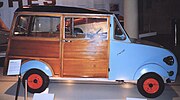


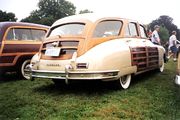








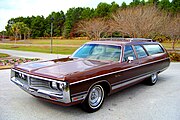
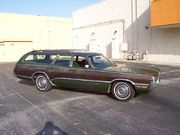



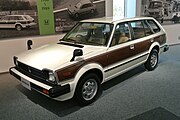



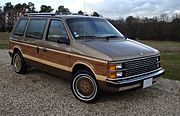




![2009 Ford Flex with horizontal grooves to evoke wood[1]](http://upload.wikimedia.org/wikipedia/commons/thumb/9/9e/2009_Ford_Flex_%28One_Quarter_Perspective%29.jpg/180px-2009_Ford_Flex_%28One_Quarter_Perspective%29.jpg)